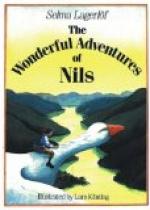“The fisherman stood on the strand waiting for her to appear again. He observed that the water around him began to take on a soft sheen, a beauty that he had never seen before. It shimmered in pink and white, like the colour-play on the inside of sea shells.
“As the glittering water lapped the shores, the fisherman thought that they too were transformed. They began to blossom and waft their perfumes. A soft sheen spread over them and they also took on a beauty which they had never possessed before.
“He understood how all this had come to pass. For it is thus with mermaids: one who beholds them must needs find them more beautiful than any one else, and the mermaid’s blood being mixed with the water that bathed the shores, her beauty was transferred to both. All who saw them must love them and yearn for them. This was their legacy from the mermaid.”
When the stately old gentleman had got thus far in his narrative he turned to Clement and looked at him. Clement nodded reverently but made no comment, as he did not wish to cause a break in the story.
“Now you must bear this in mind, Clement,” the old gentleman continued, with a roguish glint in his eyes. “From that time on people emigrated to the islands. At first only fishermen and peasants settled there, but others, too, were attracted to them. One day the king and his earl sailed up the stream. They started at once to talk of these islands, having observed they were so situated that every vessel that sailed toward Lake Maelar had to pass them. The earl suggested that there ought to be a lock put on the channel which could be opened or closed at will, to let in merchant vessels and shut out pirates.
“This idea was carried out,” said the old gentleman, as he rose and began to trace in the sand again with his cane. “On the largest of these islands the earl erected a fortress with a strong tower, which was called ‘Kaernan.’ And around the island a wall was built. Here, at the north and south ends of the wall, they made gates and placed strong towers over them. Across the other islands they built bridges; these were likewise equipped with high towers. Out in the water, round about, they put a wreath of piles with bars that could open and close, so that no vessel could sail past without permission.
“Therefore you see, Clement, the four islands which had lain so long unnoticed were soon strongly fortified. But this was not all, for the shores and the sound tempted people, and before long they came from all quarters to settle there. They built a church, which has since been called ‘Storkyrkan.’ Here it stands, near the castle. And here, within the walls, were the little huts the pioneers built for themselves. They were primitive, but they served their purpose. More was not needed at that time to make the place pass for a city. And the city was named Stockholm.




